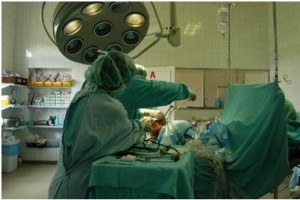AFTER-SURGERY SCARS
 An open surgery is when they form an incision through the skin to reach the organs that are going to be operated, at the site of the incision you are left with a scar. The scar may be small or prominent. There are no current ways to completely remove a surgical scar, but there are many methods to reduce it appearance. Left: Photo Credit Laparoscopic Surgery Image by Grzegorz Kwolek from Fotolia.com
An open surgery is when they form an incision through the skin to reach the organs that are going to be operated, at the site of the incision you are left with a scar. The scar may be small or prominent. There are no current ways to completely remove a surgical scar, but there are many methods to reduce it appearance. Left: Photo Credit Laparoscopic Surgery Image by Grzegorz Kwolek from Fotolia.com
Most scars have an extremely unsightly appearance at first, usually red and thick, according to the American of Dermatology. However, these scars turn out to fade with time. During 6 to 18 months, a surgical scar typically fades into a thin white line. For the young ones, tend to have more problems with oversized scars than older people, for the reason that the young skin may attempt to over-heal the area, resulting in larger scar.
TYPES
Some scars develop abnormally after surgery, but the normal surgical scars follow the standard pattern of shifting from red and thick to thin and white. The American Academy of Facial Plastic and Reconstructive Surgery quote, “keloid scars develop when the scar material outgrows it original boundaries, creating a thick, dark, raised area around the scar. Hypertrophic scars are similar to keloids but remain within the boundaries of the original incision, creating a thick, raised line instead of flat, white surface that would result from a normal scarring pattern.”
COMPLICATIONS
Complications may arise with a surgical scar, even years after the original surgery. According to the Penn State Milton S. Hershey Medical Center, an incisional hernia is one problem. Incisional hernia is when a part of the intestines or other abdominal organ protrudes through the internal portion of a surgical scar in the abdomen. Gaining weight, pregnancy or other conditions that cause and abdominal scar to stretch out and become thinner may lead to an incisional hernia.
REVISION
A revision is the process of making a scar look better or less noticeable. Many methods exist to be able to have this revision performed. According to the American Academy of Dermatology, plastic surgery is one option, another having your skin rejoined in more aesthetically pleasing fashion, and sometimes many scars can successfully be removed. Other treatments for treating post-surgery scars include dermabrasion, laser resurfacing, skin grafting and injectable fillers.
ALTERNATIVES
There are alternatives to getting a scar in the first place, or ways to limit the degree of scarring. Laproscopic surgery uses miniature cameras and tools that are threaded into the body through a small incision, allowing the surgeon to create only a few cuts for surgeries that would have required large incision years ago. The Cleveland Clinic article: “The Forefront of Surgery, Without Scars,” mentions a type of surgery called single-port surgery. The tools go through a single, tiny incision that may be placed in a location as the belly points of entry, such as the mouth.
